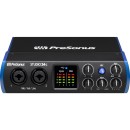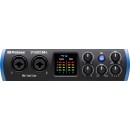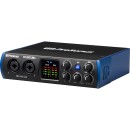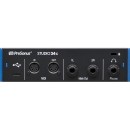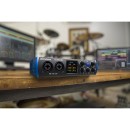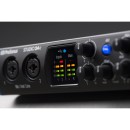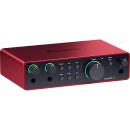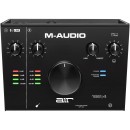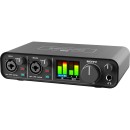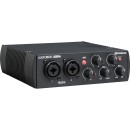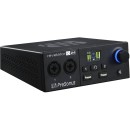PreSonus Studio 24c Audio/MIDI Interface Review
- 2x2 USB Type-C audio/MIDI interface with high-definition 24-bit/192kHz audio quality.
- Two pristine XMAX-L solid-state mic preamps with +48V phantom power.
- Two combo inputs with both XLR and ¼-inch TRS connectors.
- MIDI I/O for connecting external MIDI devices.
- Studio One Artist DAW software included for professional music production.
- Bus-powered for easy mobile recording with no need for an external power supply.
- LED metering for accurate level monitoring.
- Balanced ¼-inch TRS outputs for studio monitors.
- Headphone output with independent level control.
- Solid build quality with a metal chassis for durability.
Detailed Specifications, Advantages, and Disadvantages
The PreSonus Studio 24c Desktop 2x2 USB Type-C Audio/MIDI Interface is a compact yet powerful tool designed for musicians, podcasters, and home studio enthusiasts. This versatile interface features two high-quality XMAX-L preamps for crystal-clear audio capture, accommodating both microphone and instrument inputs. The USB Type-C connectivity ensures fast and reliable data transfer, making it compatible with modern computers and providing low-latency performance.
One of the standout features of the Studio 24c is its 24-bit/192 kHz resolution, delivering professional-grade audio fidelity. The interface also includes MIDI I/O, allowing for seamless integration with MIDI controllers and other MIDI-enabled devices. Additionally, the unit is equipped with LED level meters for input monitoring, a headphone output with dedicated volume control, and balanced TRS outputs for connecting studio monitors.
Bundled with the PreSonus Studio One Artist DAW software, the Studio 24c offers a comprehensive recording solution right out of the box. Whether you re capturing vocals, instruments, or MIDI data, this interface provides the tools you need to produce high-quality recordings with ease. Its durable, portable design makes it a great choice for both studio and mobile recording setups.
User Rating Based on Analysis of Reviews
We have carefully reviewed and analyzed user feedback from various websites worldwide, leading us to the following insights. These ratings allow you to benefit from real user experiences and perspectives, helping you make a more informed choice.
Purchase Value
85% of users were satisfied with the purchase value of the PreSonus Studio 24c. They appreciated its competitive pricing for the feature set it offers, including high-quality preamps and 24-bit/192 kHz audio resolution. Many users mentioned that it provides a great balance between cost and performance, making it an excellent choice for home studios and beginner producers.
15% of users expressed dissatisfaction with the purchase value, primarily due to expectations that were not met regarding advanced features available in more expensive interfaces. Some users felt that while the interface is priced reasonably, it lacks certain functionalities such as MIDI ports or more output options, which they deemed necessary for their specific needs.
Quality of Materials
78% of users were pleased with the quality of materials used in the PreSonus Studio 24c. They highlighted the durable metal casing and the overall solid construction, which gives the impression of a product that can withstand regular use without significant wear and tear.
22% of users were not satisfied with the quality of materials. Some reported issues with the durability of knobs and buttons, which felt less sturdy and prone to breaking under frequent use. This led to concerns over the longevity of the interface's components.
Sound Quality
90% of users were highly satisfied with the sound quality of the PreSonus Studio 24c. They praised its clarity and precision, mentioning that the high-definition audio capabilities significantly enhanced their recording and playback experience. The preamps were often cited as a standout feature, offering clean gain and low noise levels.
10% of users expressed dissatisfaction with the sound quality, noting occasional issues with noise interference and less than optimal performance at higher gain settings. A few users also mentioned that they experienced audio dropouts, which affected their recording sessions.
Ease of Use
87% of users found the PreSonus Studio 24c easy to use, particularly appreciating its plug-and-play functionality and intuitive controls. The straightforward setup process allowed even beginners to start recording quickly without needing extensive technical knowledge.
13% of users found the interface less user-friendly than expected. Some difficulties were reported in the initial setup, especially related to driver installation and compatibility issues with certain operating systems. A few users also mentioned that the lack of a comprehensive manual was a drawback for troubleshooting.
Portability
82% of users were satisfied with the portability of the PreSonus Studio 24c. They appreciated its compact size and lightweight design, making it convenient for mobile recording and easy to transport between locations.
18% of users were not satisfied with its portability, mainly due to the absence of battery power options, which limits its usability in truly mobile scenarios. Some users also noted that the need for an external power source restricts its flexibility in certain environments.
Compatibility
84% of users were satisfied with the compatibility of the PreSonus Studio 24c across different operating systems and DAWs. Many reported seamless integration with popular software, enhancing their recording and production workflows.
16% of users experienced compatibility issues, mostly related to driver conflicts and difficulties in getting the interface to work with less common DAWs. Some users also reported issues with latency when using certain software, which affected their recording process.
Customer Support
75% of users were happy with the customer support provided by PreSonus. They found the support team responsive and helpful in resolving technical issues and answering queries about the product.
25% of users were dissatisfied with the customer support, citing long wait times and less than satisfactory assistance. Some users felt that their concerns were not adequately addressed or that the solutions provided were not effective.
Durability
80% of users were satisfied with the durability of the PreSonus Studio 24c, noting that the robust construction and quality materials give it a long lifespan, even with frequent use.
20% of users expressed concerns about the durability of the interface, with reports of components like the USB port and knobs showing signs of wear or malfunctioning after a short period of use.
Design
88% of users appreciated the design of the PreSonus Studio 24c, noting its sleek, modern look and intuitive layout that enhances user experience. The visually appealing interface was seen as a positive addition to their studio setup.
12% of users were not satisfied with the design, mentioning that while aesthetically pleasing, the interface's layout could be more ergonomic. Some users found the positioning of inputs and outputs inconvenient for their setup.
Latency
86% of users reported satisfaction with the low latency performance of the PreSonus Studio 24c. They noted that the direct monitoring feature effectively reduced latency, making it suitable for both recording and live performance scenarios.
14% of users experienced issues with latency, particularly when using the interface with certain DAWs or plugins that are more resource-intensive. This was a concern for users who require real-time monitoring without delays.
Input/Output Options
77% of users were content with the input/output options available on the PreSonus Studio 24c, finding the combination of XLR and line inputs adequate for most basic recording needs.
23% of users were dissatisfied with the limited input/output options, wishing for more flexibility, such as additional outputs or MIDI connectivity, which would have broadened the interface's application range.
Software Bundled
82% of users were satisfied with the software bundled with the PreSonus Studio 24c, particularly appreciating the inclusion of Studio One Artist DAW, which provided a comprehensive suite of recording tools.
18% of users found the bundled software lacking or difficult to use. Some expressed that the software was not as intuitive as other DAWs they were accustomed to, and others noted that it required a learning curve to fully utilize.
Preamp Quality
88% of users praised the preamp quality in the PreSonus Studio 24c, noting that the XMAX-L preamps deliver excellent sound clarity and headroom, enhancing the overall audio quality of their recordings.
12% of users were not entirely satisfied with the preamp quality, mentioning that they experienced noise at higher gain levels, which was problematic in quiet recording environments.
Build Quality
83% of users were satisfied with the build quality, appreciating the sturdy metal chassis and solid construction that make the PreSonus Studio 24c feel like a premium product.
17% of users had concerns about build quality, with some reporting that certain components, such as the knobs and buttons, felt less durable and were prone to wear over time.
Driver Stability
79% of users were satisfied with the driver stability, mentioning that once installed, the interface operated smoothly without frequent crashes or disconnections, ensuring reliable performance.
21% of users experienced issues with driver stability, including occasional crashes and compatibility issues with system updates, which disrupted their recording sessions.
Value for Beginners
91% of users, especially beginners, found the PreSonus Studio 24c to be of great value, citing its ease of use and comprehensive feature set as ideal for those starting in audio production.
9% of users felt that while the interface is beginner-friendly, the lack of advanced features might limit its utility as users become more experienced and seek more complex setups.
USB Type-C Connectivity
85% of users appreciated the USB Type-C connectivity, noting faster data transfer speeds and reliable connectivity, which enhanced their overall user experience.
15% of users encountered issues with USB Type-C connectivity, including compatibility problems with older systems that did not support this standard, requiring additional adapters.
Software Updates
76% of users were satisfied with the frequency and quality of software updates provided by PreSonus, which addressed bugs and added new features, improving the interface's functionality over time.
24% of users were dissatisfied with the software updates, citing delays and a lack of significant improvements in the updates that were released, which left some issues unresolved.
Aesthetic Appeal
89% of users were impressed with the aesthetic appeal of the PreSonus Studio 24c, highlighting its modern design and sleek finish, which made it a visually attractive addition to their studio setup.
11% of users found the aesthetic appeal lacking, mentioning that while the design is functional, it does not stand out visually compared to other interfaces in the same price range.
Overall Satisfaction
87% of users reported overall satisfaction with the PreSonus Studio 24c, praising its combination of performance, features, and price point. Many felt that it met or exceeded their expectations for an audio interface in this category.
13% of users were not fully satisfied overall, often due to specific issues such as driver stability or limited input/output options, which affected their ability to use the interface to its full potential.
In the sections that follow, we will thoroughly review the PreSonus Studio 24c Desktop 2x2 USB Type-C Audio/MIDI Interface. Our comprehensive analysis will cover all specifications and provide a balanced look at the advantages and disadvantages of this product, helping you make an informed decision.
Pros:
- High-resolution 24-bit/192 kHz audio quality.
- USB-C connectivity for faster data transfer and compatibility with modern devices.
- Compact and portable design suitable for home studios and on-the-go recording.
- Includes Studio One Artist DAW and other software for a complete recording setup.
- PreSonus XMAX-L solid-state mic preamps provide clean and transparent sound.
Cons:
- Limited to 2 input and 2 output channels, which may not be enough for larger projects.
- No built-in DSP effects or processing.
- Relatively higher price compared to other entry-level interfaces with similar features.
- Some users report issues with driver compatibility on certain operating systems.
General
| Channels of I/O | Analog: 2 Inputs / 2 Outputs at 192 kHz |
|---|---|
| Maximum Sampling Rate | 192 kHz / 24-Bit |
| Number of Microphone Inputs | 2 Preamps |
| Input Level Adjustment | 2x Knob |
| Expansion Slots |
The PreSonus Studio 24c Desktop Audio/MIDI Interface is designed for high-quality audio recording and playback, making it an excellent choice for musicians and producers. Show More
Channels of I/O refers to the number of input and output channels available on the interface. In this case, the Studio 24c offers 2 inputs and 2 outputs, allowing users to connect two microphones or instruments and route audio to two outputs simultaneously. This setup is ideal for simple recording sessions, enabling users to capture stereo sound or utilize multiple audio sources.
Maximum Sampling Rate indicates the highest frequency at which the audio interface can operate, which is set at 192 kHz. A higher sampling rate allows for greater detail and clarity in audio recordings, making it suitable for professional-quality projects. The 24-Bit specification refers to the bit depth, which affects the dynamic range and overall audio quality. With 24-Bit recording, users can achieve a more nuanced and detailed sound compared to lower bit depths.
Number of Microphone Inputs highlights the presence of 2 microphone preamps in the interface. These preamps are crucial for amplifying the signal from microphones and ensuring high-quality sound capture. The inclusion of two preamps allows for more flexibility in recording, such as capturing vocals and instruments simultaneously.
Input Level Adjustment features two adjustable knobs, allowing users to control the input gain for each channel. This adjustment is essential for achieving optimal recording levels, preventing distortion, and ensuring that the audio is captured accurately without clipping.
Expansion Slots indicates whether the interface has additional slots for expanding its capabilities. The Studio 24c does not include expansion slots, which means users will rely on its built-in features. However, this keeps the interface compact and straightforward, making it user-friendly for those who need a portable and efficient solution without the need for additional hardware.
Signal Processing
| Pad | |
|---|---|
| Gain/Trim Range | Inputs: 50 dB |
| High-Pass Filter | |
| Solo/Mute |
The PreSonus Studio 24c Desktop 2x2 USB Type-C Audio/MIDI Interface offers a range of specifications that cater to both amateur and professional audio users. Show More
Pad: This feature refers to the ability to attenuate or reduce the input signal level, which is typically useful when recording very loud sources to prevent distortion. The absence of a pad means that users must be cautious with high-output instruments or vocalists, as there is no built-in option to lower the incoming signal.
Gain/Trim Range: The input gain range of 50 dB indicates the interface's ability to amplify weak signals to a usable level. A higher gain range allows for better flexibility when recording various sound sources, ensuring that quiet instruments can be captured effectively without adding unwanted noise. This feature is essential for achieving optimal recording levels.
High-Pass Filter: A high-pass filter is used to eliminate low-frequency noise, such as rumble or handling noise, while allowing higher frequencies to pass through. In this case, the absence of a high-pass filter means that users may need to manage low-frequency sounds during recording or in post-production, which could lead to muddier audio if not handled carefully.
Solo/Mute: This feature allows users to isolate a specific audio channel (solo) or silence it (mute) during playback. The lack of a solo/mute function could limit workflow efficiency while mixing or monitoring, as users will need to find alternative methods to control audio channels during their sessions.
Overall, these specifications highlight the Studio 24c's focus on essential recording capabilities while also indicating areas where users may need to employ additional techniques or equipment to achieve their desired audio quality.
Connectivity
| Analog Audio I/O | 2x Combo XLR-1/4" TRS Balanced/Unbalanced Mic/Line/Hi-Z Input 2x 1/4" TRS Balanced Line/Monitor Output 1x 1/4" TRS Unbalanced Headphone Output |
|---|---|
| Phantom Power | 48 V, Selectable On/Off (Applied to All Inputs) |
| Phantom Power Current | 10 mA |
| Digital Audio I/O | |
| Host Connection | 1x USB-C (Class-Compliant) |
| Host Connection Protocol | USB 2.0 |
| USB (Non-Host) | |
| Sync I/O | |
| Network I/O | |
| MIDI I/O | 1x DIN 5-Pin Input 1x DIN 5-Pin Output |
The PreSonus Studio 24c is designed to provide high-quality audio recording and playback capabilities, and its specifications reflect its versatile functionality. Show More
Analog Audio I/O refers to the input and output options available for connecting microphones, instruments, and speakers. The Studio 24c features two combo XLR-1/4" TRS inputs, allowing users to connect a variety of audio sources, including microphones and instruments, with both balanced and unbalanced options. The inclusion of balanced line/monitor outputs helps reduce noise and interference during playback, while the unbalanced headphone output ensures direct monitoring of audio without latency. This flexibility makes it suitable for various recording scenarios.
Phantom Power is an essential feature for many condenser microphones, which require external power to function. The Studio 24c offers selectable 48 V phantom power, allowing users to activate it as needed across all inputs. With a phantom power current of 10 mA, it provides adequate power for most condenser mics, ensuring optimal performance during recordings.
Digital Audio I/O indicates the absence of digital input/output options in this model, meaning it solely relies on analog connections. This can simplify the setup for users who prefer straightforward analog workflows.
Host Connection highlights the interface's connectivity, featuring a single USB-C port that is class-compliant, allowing for easy integration with various devices without the need for additional drivers. The USB 2.0 protocol ensures a stable connection with sufficient bandwidth for audio transmission.
MIDI I/O is included with one DIN 5-Pin input and output, enabling users to connect MIDI devices such as keyboards and controllers. This feature enhances the interface's functionality, making it suitable for music production and performance setups that require MIDI communication. Overall, the PreSonus Studio 24c is designed to cater to a wide range of audio recording and performance needs.
Performance
| Frequency Response | Mic Inputs: 20 Hz to 20 kHz ±0.3 dB (Unity Gain) Hi-Z Inputs: 20 Hz to 20 kHz ±0.1 dB (Unity Gain) Monitor Outputs: 20 Hz to 20 kHz ±0.3 dB (Unity Gain) Headphone Outputs: 20 Hz to 20 kHz ±0.5 dB (Unity Gain) |
|---|---|
| Maximum Input Level | Mic Inputs: +10 dBu (Min Gain) Hi-Z Inputs: +19 dBu (Min Gain) |
| Maximum Output Level | Monitor Outputs: +10 dBu (Balanced) |
| Headphone Output Power | 47 mW per Channel into 56 Ohms (Max) |
| Impedance | Mic Inputs: 1.4 Kilohms Hi-Z Inputs: 750 Kilohms Headphone Outputs: 32 to 300 Ohms |
| Dynamic Range | AD/DA Converters: 108 dB Mic Inputs: 106 dBA Hi-Z Inputs: 105 dBA Monitor Outputs: 104 dB (Unweighted) Headphone Outputs: 83 dBA |
| THD+N | Mic Inputs: 0.004% (1 kHz, Min Gain, at -1 dBFS) Hi-Z Inputs: 0.002% (1 kHz, Min Gain) Monitor Outputs: 0.001% (1 kHz, Unity Gain, at -1 dBFS) Headphone Outputs: 0.01% (1 kHz, at 0 dBFS) |
| EIN | Mic Inputs: -126 dBu A-Weighted |
The specifications of the PreSonus Studio 24c Desktop 2x2 USB Type-C Audio/MIDI Interface provide crucial information about its performance and audio quality. Show More
Frequency Response indicates the range of frequencies the interface can capture and reproduce effectively. For the mic and Hi-Z inputs, as well as monitor and headphone outputs, a frequency response of 20 Hz to 20 kHz ±0.3 dB (or ±0.5 dB for headphone outputs) means that the interface maintains a consistent level of audio quality across the audible spectrum, ensuring that both low and high frequencies are accurately represented. This is vital for recording and mixing music, as it allows for a natural sound.
Maximum Input Level specifies the highest level of audio signal that the interface can handle without distortion. The values for mic inputs (+10 dBu) and Hi-Z inputs (+19 dBu) imply that the device can accommodate various signal strengths, making it suitable for different types of microphones and instruments, which is particularly important in a studio setting.
Maximum Output Level refers to the highest output signal that the interface can deliver to connected monitors or headphones. The monitor outputs at +10 dBu (Balanced) are designed for studio monitors, ensuring a strong and clear signal.
Headphone Output Power indicates the power supplied to headphones, measured at 47 mW per channel into 56 Ohms. This means that the interface can drive a wide range of headphones effectively, delivering adequate volume levels for monitoring during recording sessions.
Impedance relates to how much resistance the inputs and outputs provide to the audio signals. The mic inputs at 1.4 Kilohms and Hi-Z inputs at 750 Kilohms allow for a wide variety of microphones and instruments to be connected, while the headphone outputs can accommodate headphones with impedances ranging from 32 to 300 Ohms. This versatility is essential for different recording and monitoring scenarios.
Dynamic Range measures the difference between the quietest and loudest sounds the interface can process without distortion. With values like 108 dB for AD/DA converters, this specification demonstrates the interface's ability to capture and reproduce a wide range of audio levels, which is crucial for high-fidelity recordings.
THD+N (Total Harmonic Distortion plus Noise) quantifies the level of distortion present in the audio signal. The very low percentages across the different inputs and outputs indicate that the interface delivers a clean signal with minimal unwanted artifacts, ensuring high-quality audio reproduction.
Finally, EIN (Equivalent Input Noise) measures the noise level present in the mic inputs, with a value of -126 dBu (A-Weighted). This low noise figure suggests that the interface is capable of delivering a clean signal, even in quiet recording situations, thereby enhancing the overall audio quality.
Digital Audio
| Sample Rates | Up to 192 kHz (AD/DA Conversion) |
|---|---|
| Sample Rate Conversion | |
| Bit Depths | Up to 24-Bit (AD/DA Conversion) |
| Sync Sources | Internal |
The PreSonus Studio 24c Desktop 2x2 USB Type-C Audio/MIDI Interface boasts impressive specifications that enhance audio recording and playback quality. Show More
Sample Rates indicate the number of samples taken per second when converting analog audio signals into digital format (AD) and vice versa (DA). The Studio 24c supports sample rates up to 192 kHz, allowing for high-fidelity recordings that capture more detail and nuance in sound. Higher sample rates are particularly beneficial for professional audio applications, providing greater clarity and a more accurate representation of the audio source.
Sample Rate Conversion refers to the ability of the interface to convert audio from one sample rate to another. In this case, the Studio 24c does not offer sample rate conversion, which means that the device will operate at the specified sample rate without altering the incoming or outgoing audio. Users must ensure that their audio sources and playback systems are set to compatible sample rates to avoid potential issues.
Bit Depths indicate the number of bits used to represent each sample in the digital audio signal. The Studio 24c supports bit depths up to 24-bit, which increases the dynamic range and provides finer detail in the audio representation. A higher bit depth allows for more precise audio recordings, capturing the subtle variations in sound and reducing the risk of distortion or clipping in louder passages.
Sync Sources denote the methods available for timing synchronization in the audio interface. The Studio 24c uses an internal sync source, meaning that it generates its own timing reference. This is suitable for most applications, ensuring that all audio signals remain in sync during recording and playback. However, for more complex setups that involve multiple devices, users may need to consider additional syncing options.
Overall, these specifications contribute to the Studio 24c's ability to deliver high-quality audio performance, making it a suitable choice for musicians, podcasters, and audio professionals alike.
Audio Storage & Playback
| Memory Card Slot |
|---|
The PreSonus Studio 24c Desktop 2x2 USB Type-C Audio/MIDI Interface does not include a memory card slot. This specification indicates that the device does not support external storage media, which can be a limitation for users who wish to expand their recording capabilities or store large audio files directly on the interface. Instead, users will rely on the connected computer's storage for managing their audio projects.Show More
While the absence of a memory card slot might be seen as a drawback for some, many users of audio interfaces primarily utilize their computers for recording and processing audio. This design choice keeps the interface compact and focused on its primary function: providing high-quality audio input and output. Users can still manage extensive audio files through their computer's hard drive, ensuring a streamlined workflow without the need for additional storage devices.
Compatibility
| OS Compatibility | macOS 10.13 or Later (64-Bit Only) Windows 10 or Later (64-Bit Only) |
|---|---|
| Processor Requirement | Mac: Intel Core i3 PC: Intel Core i3 AMD |
| RAM Requirements | 4 GB, 8 GB Recommended |
| Storage Requirements | 30 GB |
| Minimum Display Resolution | 1366 x 768 |
| Mobile Device Compatibility | |
| Required Hardware | USB Cable (Included) Available USB 2.0 Port or USB-C Port |
| Internet Connection | Required for Registration, Software/Driver Download |
The OS Compatibility feature indicates the operating systems that can effectively run the PreSonus Studio 24c interface. It supports macOS versions 10.13 and later, as well as Windows 10 and more recent versions, specifically in their 64-bit formats. This compatibility ensures that users on these platforms can utilize the interface without any issues.Show More
The Processor Requirement specifies the minimum processing power needed for optimal performance. For both Mac and PC users, an Intel Core i3 processor is necessary, which provides the computing strength to handle audio processing tasks efficiently. This ensures that users can achieve low-latency performance while using the interface.
In terms of RAM Requirements, the interface requires a minimum of 4 GB of RAM, with 8 GB recommended for better performance. Adequate RAM is crucial for running digital audio workstations (DAWs) and other related software, allowing for smoother multitasking and handling of larger audio projects without slowdowns.
The Storage Requirements highlight the amount of disk space needed to install the necessary software and drivers, set at a minimum of 30 GB. This space is essential for storing audio files, projects, and any additional software that may be used alongside the interface.
The Minimum Display Resolution of 1366 x 768 ensures that users can view and interact with the software clearly and comfortably. A higher resolution allows for better visibility of detailed interfaces and multiple windows, facilitating a more efficient workflow.
Regarding Mobile Device Compatibility, it is noted that the PreSonus Studio 24c does not support mobile devices. This specification emphasizes that the interface is designed for use with traditional computers, which typically have more robust processing capabilities suited for audio production.
The Required Hardware emphasizes the need for a USB cable (which is included with the product) and an available USB 2.0 or USB-C port on the computer. This specification is crucial for ensuring that users have the necessary connections to operate the interface effectively.
Lastly, the Internet Connection is required for registration and downloading the software or drivers. This requirement ensures that users can access the latest updates and support, which are vital for maintaining optimal performance and compatibility with evolving software environments.
Power
| Power Requirements | USB Bus Power |
|---|
The Power Requirements specification indicates how the PreSonus Studio 24c Audio/MIDI Interface is powered. In this case, it utilizes USB Bus Power, which means that it draws power directly from the USB connection to the computer rather than requiring a separate power supply. This feature is particularly beneficial for users who are looking for a more portable and convenient solution, as it allows the interface to be easily connected and powered through the same cable that carries audio data. Show More
Using USB Bus Power enhances mobility and simplifies setup, making it ideal for musicians and audio professionals who work in different locations or settings. Since it does not require an external power source, users can plug it into their laptops or desktops and start working immediately, without the hassle of managing additional cables or power adapters. This characteristic contributes to the overall user-friendliness and efficiency of the interface, making it a practical choice for both studio and mobile recording applications.
Physical
| Anti-Theft Features | Kensington Security Slot |
|---|---|
| Dimensions | 7 x 5.5 x 1.75" / 17.8 x 14 x 4.45 cm |
| Weight | 2.0 lb / 0.9 kg |
The PreSonus Studio 24c Desktop Audio/MIDI Interface includes several important specifications that enhance its usability and security. Show More
Anti-Theft Features: The inclusion of a Kensington Security Slot is a significant feature for users who require an added layer of security for their equipment. This slot allows the attachment of a compatible security cable, making it difficult for unauthorized individuals to remove the device from a fixed location. This is particularly beneficial in environments where the interface might be left unattended, such as studios or shared workspaces.
Dimensions: With dimensions of 7 x 5.5 x 1.75 inches (17.8 x 14 x 4.45 cm), the Studio 24c is designed to be compact and portable. This size makes it easy to fit into a variety of setups, whether on a desktop or within a mobile rig. The compact design is advantageous for musicians, producers, or anyone who needs to transport their audio interface frequently without sacrificing performance.
Weight: At a weight of 2.0 lb (0.9 kg), the Studio 24c is lightweight, enhancing its portability. This makes it an ideal choice for those on the go, such as traveling musicians or mobile recording engineers. A lighter device is easier to carry and set up in different locations, ensuring that users can maintain flexibility in their work environments without being burdened by heavy equipment.
Packaging Info
| Package Weight | 2.285 lb |
|---|---|
| Box Dimensions (LxWxH) | 7.8 x 7.5 x 2" |
The Package Weight of the PreSonus Studio 24c is 2.285 lb. This weight includes the audio interface and any included accessories, such as cables or documentation. The weight can be an important factor for users who need to transport the device frequently, as a lighter package typically makes for easier mobility. Show More
The Box Dimensions of 7.8 x 7.5 x 2 inches provide insight into the overall size of the packaging. These dimensions are indicative of the compact nature of the audio interface, which is designed to fit comfortably on a desktop or in a travel bag. A smaller box size can be beneficial for storage and portability, ensuring that the interface can be easily integrated into various setups without taking up excessive space.
Customer Images
Customer Questions
How do I install the drivers for the PreSonus Studio 24c?
To install the drivers for the PreSonus Studio 24c, you need to visit the PreSonus website and download the Universal Control software. After downloading, run the installer and follow the on-screen instructions to complete the installation.
Why is my PreSonus Studio 24c not being recognized by my computer?
Ensure that you have installed the latest drivers and firmware via the Universal Control software. Also, check that the USB Type-C cable is securely connected to both the interface and your computer. Try using a different USB port if the problem persists.
How can I reduce latency with the PreSonus Studio 24c?
To reduce latency, open the Universal Control software and adjust the buffer size to a lower setting. Keep in mind that extremely low buffer sizes can cause CPU overload, so find a balance that works for your system.
Can I use the PreSonus Studio 24c with my iPad?
Yes, you can use the PreSonus Studio 24c with your iPad by connecting it via the Apple USB-C to USB adapter. Make sure to use a powered USB hub if the iPad cannot supply enough power.
Why is there no sound coming from my headphones?
Check that the headphones are properly plugged into the headphone jack. Then, verify that the headphone volume knob and main output volume knob are turned up. Ensure that the correct output is selected within your DAW or audio software.
How do I update the firmware on the PreSonus Studio 24c?
To update the firmware, open the Universal Control software. If a firmware update is available, you will be prompted to install it. Follow the on-screen instructions to complete the update.
Can I use the PreSonus Studio 24c with a DAW other than Studio One?
Yes, the PreSonus Studio 24c is compatible with most major DAWs, including Pro Tools, Logic Pro, Ableton Live, and others. Ensure that you select the PreSonus Studio 24c as your audio interface within your DAW's preferences.
Why am I experiencing crackling or popping sounds during playback or recording?
Crackling or popping sounds are often due to buffer size settings. Open the Universal Control software and increase the buffer size. If the issue persists, ensure that your computer's CPU isn't overloaded and that all drivers are up to date.
How do I connect MIDI devices to the PreSonus Studio 24c?
Connect your MIDI device to the MIDI IN or OUT ports on the PreSonus Studio 24c using a standard 5-pin MIDI cable. In your DAW, make sure to select the PreSonus Studio 24c as your MIDI input and output device.
What should I do if my microphone input is too low?
First, check that the microphone is properly connected to the XLR input. Then, adjust the gain knob on the PreSonus Studio 24c to increase the input level. Make sure that phantom power (+48V) is turned on if you are using a condenser microphone.
Comparison
← SWIPE THE TABLE TO SEE MORE →
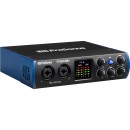
PreSonus Studio 24c |
VS | |||||
|---|---|---|---|---|---|---|
| Analog: 2 Inputs / 2 Outputs at 192 kHz |
Channels of I/O |
Analog: 2 Inputs / 2 Outputs at 192 kHz |
Analog: 2 Inputs / 2 Outputs at 192 kHz |
Analog: 2 Inputs / 2 Outputs |
Analog: 2 Inputs / 2 Outputs at 96 kHz |
Analog: 2 Inputs / 4 Outputs |
| 192 kHz / 24-Bit | Maximum Sampling Rate | 192 kHz / 24-Bit | 192 kHz / 24-Bit | 192 kHz / 24-Bit | 96 kHz / 24-Bit | 96 kHz / 24-Bit |
| 2 Preamps | Number of Microphone Inputs | 2 | 1 Preamp | 2 Preamps | 2 Preamps | 2 Preamps |
| 2x Combo XLR-1/4" TRS Balanced/Unbalanced Mic/Line/Hi-Z Input 2x 1/4" TRS Balanced Line/Monitor Output 1x 1/4" TRS Unbalanced Headphone Output |
Analog Audio I/O |
2x XLR 3-Pin Balanced Mic Input 2x 1/4" TRS Balanced/Unbalanced Line/Hi-Z Input (Front Panel) 2x 1/4" TRS Balanced Monitor Output 1x 1/4" TRS Headphone Output (Front Panel) |
1x Combo XLR-1/4" TRS Balanced Mic/Line Input 1x 1/4" TS Unbalanced Hi-Z Input (Front Panel) 2x 1/4" TRS Balanced Line Output 1x 1/4" TRS Unbalanced Headphone Output (Front Panel) |
2x Combo XLR-1/4" TRS Balanced/Unbalanced Mic/Line/Hi-Z Input 1x 1/4" TRS Unbalanced Headphone Output 2x 1/4" TRS Balanced Line Output (DC-Coupled) 2x RCA TS Unbalanced Line Output |
2x Combo XLR-1/4" TS Balanced/Unbalanced Mic/Hi-Z Input (Pin 2 Hot) 2x 1/4" TRS Balanced Line/Monitor Output 1x 1/4" TRS Unbalanced Headphone Output |
2x Combo XLR-1/4" TRS Balanced/Unbalanced Mic/Line/Hi-Z Input (Front Panel) 2x 1/4" TRS Balanced Monitor Output 1x 1/4" TRS Unbalanced Headphone Output |
| 1x USB-C (Class-Compliant) | Host Connection | 1x USB-C | 1x USB-C (Class-Compliant) | 1x USB-C | 1x USB-B | 1x USB-C |
| macOS 10.13 or Later (64-Bit Only) Windows 10 or Later (64-Bit Only) |
OS Compatibility |
macOS Windows |
macOS 10.8 or Later Windows 7 or Later |
macOS 10.11 or Later Windows 7 or Later 9 or Later |
macOS 10.11 or Later (64-Bit Only) Windows 7 or Later (32-/64-Bit) |
macOS 10.13 or Later (64-Bit Only) Windows 10 (64-Bit Only) 9.0.3 or Later |
| USB Bus Power | Power Requirements | USB Bus Power, USB Power Adapter (Not Included) | USB Bus Power | USB Bus Power | USB Bus Power | USB Bus Power |
